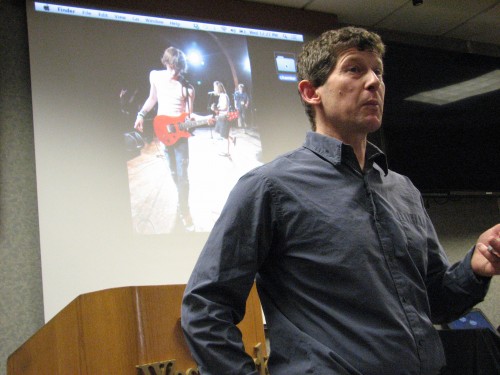
Roger Schmidt says the arts are one of the top reasons people choose to live in certain communities. (KCAW photo/Robert Woolsey)
Director Roger Schmidt told the Sitka Chamber of Commerce last week that business at the camp had grown by a factor of 32, since he was named to the post in 2000.
The budget that year, Schmidt said, was $70,000.
Schmidt compared the growth of the arts in Sitka to places like Chautauqua, New York, Banff, Alberta, and Aspen, Colorado. Banff is a town only a little bit larger than Sitka, but has an arts program that generates tens of millions of dollars in annual revenue.
In Aspen, Schmidt said, the arts produce more income than skiing.
Schmidt suggested that it was time Sitka began to see itself the way others do.
“We’re a long way from being an Aspen or a Banff, and we may never be an Aspen or a Banff or Chautauqua. But I guess I’d really like to present that to Sitka — it’s a powerful resource that can be leveraged over and over and over again, if we take that route to make Sitka the most attractive place for talent to be raised, for talent to be retained, for talent to be attracted to. The most attractive town for visitors to come and spend more time, and for their families to figure out a way to make Sitka more of a destination.”
Schmidt said the camp achieved an unprecedented level of stability when it received the core Sheldon Jackson Campus in 2011 from the defunct college’s board of trustees. Not having a reliable home inhibited growth.
But the campus also came with some major liabilities. It had been boarded up for nearly four years. Schmidt said he took pains to avoid the campus.
“I didn’t go up Jeff Davis Street anymore, unless I had to. It just depressed me at a very deep level.”
Now, Schmidt said, 46-percent of his budget is spent on capital improvements. He said the work would literally never end.
“I think that we’re in the worst moment of historical battle that one can be at. But any large, 100-plus-year-old campus is just a constant capital project. Three years ago when we started it was in so many ways impossible to use. One of the things we’ve worked is to make more of the spaces non-seasonal. You know, the first year of camp we literally had no heat anywhere on campus.”
Having a heated permanent home has allowed the camp to expand programs. Schmidt said the camp now enrolls 1,000 students from 38 Alaskan communities, 27 states, and 5 countries. But tuition accounts for only 23-percent of the camp’s revenue. He stressed that contributions remain a major factor in the camp’s success — contributions which can be leveraged time and time again into matching grant funding.
Schmidt described the camp as a component of Sitka’s visitors’ industry — one which cultivated very deep ties to the community. Really deep ties.“And we have so many multi-generational families that come to the camp, whether they’re teachers, or children, or grandchildren. People getting married at camp… uh, not married at camp… married because they met at camp. They do the preliminary work here!”
And the work — the work of restoring the campus, that is — goes on. Schmidt said over 700 community members have logged 30,000 volunteer hours helping prepare the campus for the arrival of students each summer.
And all those sheets of plywood over that boarded over campus windows?
“We’ve used them for theater sets, to drive our tractors on the lawn, to replace rotten subfloors. So, all that plywood’s gone to good use.”































